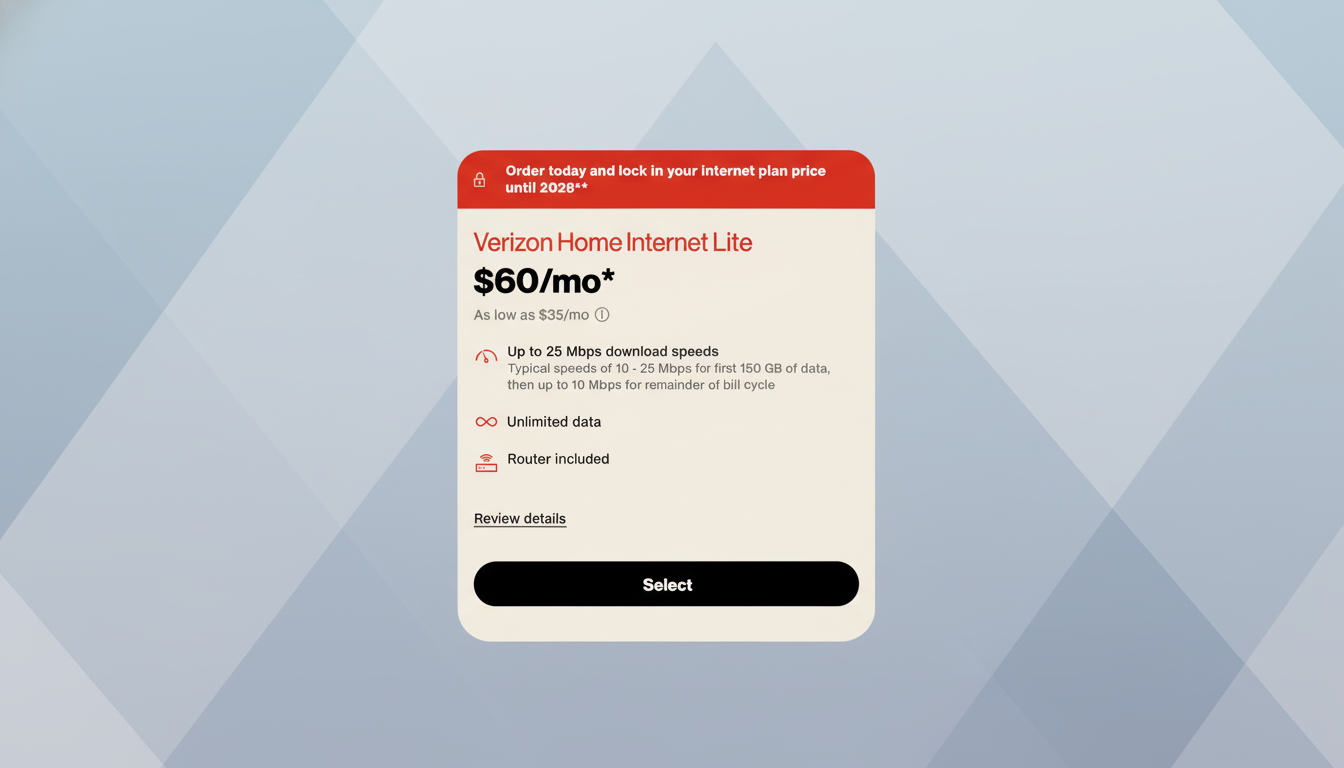If you think your monthly internet bill is spiraling out of control, Verizon’s new Home Internet Lite plan has you firmly in its sights. The offer is aimed at homes that fall outside the company’s fiber and 5G home internet businesses and promises an easy setup, predictable pricing as low as $20 to start for those who qualify.
What to Expect from Verizon Home Internet Lite
Home Internet Lite features unlimited data with download speeds of up to 25 Mbps, and Verizon says the majority of people will see speeds ranging from 10–25 Mbps. After 150GB of monthly usage, during the remainder of your billing cycle download speeds are reduced to 10 Mbps. A Wi‑Fi router is provided at no additional cost, and the service is built for a fast, out‑of‑the‑box self‑install.

The plan uses Verizon’s wireless network to bring high-speed internet service to areas that are not wired for Fios fiber or 5G home internet. Verizon asserts the availability is nationwide, but eligibility is address‑based, which means you will need to do a quick check for availability before you commit.
Who Qualifies and How the Pricing Works at Verizon
The regular monthly rate is $60, but there are many ways to reduce it. Sign up for autopay and paper‑free billing, and you’ll save $10. Eligible customers with a Verizon mobile plan can layer on more discounts — some of the bundles are advertised for $35 per month. Verizon also provides an option to commit for 36 months, which will freeze the monthly price at $25 per month for three years.
For qualifying federal assistance program households like SNAP, the Verizon Forward program can reduce that monthly cost to $20. That income-qualified pricing is designed to broaden the accessibility of affordable home internet to families that have traditionally counted on slower DSL lines or more costly satellite options. Taxes and fees could apply, and all discounts will be under Verizon’s terms.
The availability criteria are simple: your address must generally fall outside Verizon’s 5G Home or Fios coverage area. If faster options are available at your address, you will be directed to those plans instead.
What 25 Mbps Can Do for Home Internet Users
With download speeds firing on all cylinders at 25 Mbps, power users won’t be blown away, but you’ll get the basics covered. Look for easy web browsing, social media usage, email management, music streaming, and phone cloud backups and 1–2 HD video streams without congestion on the connection. Video calls ought to work at 720p, although group calls or screen sharing might test the threshold.

After 150 GB of data use, the maximum speed is ideal for standard‑definition streaming and casual activities. Upload performance isn’t the story here; for creators, heavy file transfers, or latency‑sensitive gaming, fiber or higher‑tier 5G home service is still a better fit.
Why This Matters for Unserved and Underserved Areas
Millions of households remain out of reach of robust fiber and 5G service, according to the FCC’s National Broadband Map. In much of these places, families decide between old DSL lines or satellite, which can entail trade‑offs in speed, latency and price. A home wireless plan with a predictable price point and free router, on the other hand, makes the switch an easier decision.
You don’t need Ookla to tell you that there is a speed gap — industry tracking does, with the median U.S. fixed download speed clocking in at well over 200 Mbps this year, an order of magnitude beyond the 25 Mbps cap vectored for here. But price is still a consideration for many households. Access to a computer is one of the strongest factors associated with home broadband adoption, but affordability also remains among the top reasons some Americans don’t subscribe to internet service at home, according to Pew Research Center findings on internet use. A $20 option targeted at basic connectivity might help bridge that affordability gap, even if it didn’t deliver urban fiber performance.
Key Caveats and What’s Next for Verizon Home Internet
As with any wireless home service, speeds may vary based on signal strength and network congestion. The 36‑month price‑lock is a multi‑year commitment, and you need to be eligible for the $20 tier under programs that Verizon Forward supports. You can usually opt for one of those plans once your area gains Fios or 5G Home, to get faster speeds.
If your internet bill hurts the wallet, fiber isn’t on your block and transfer speeds aren’t a priority, Home Internet Lite is worth considering. Verify your address, collect any documents if you do qualify for a program of assistance, and see how the discounted offers measure up against what your current service charges (and delivers). This may be the easiest way for a lot of households to maintain reliable home internet without overpaying.

